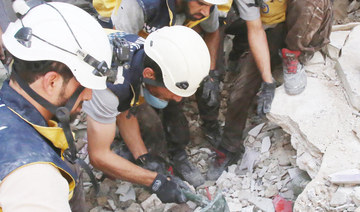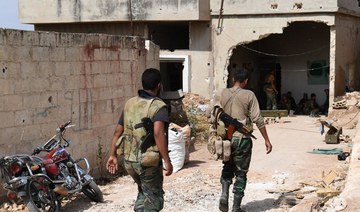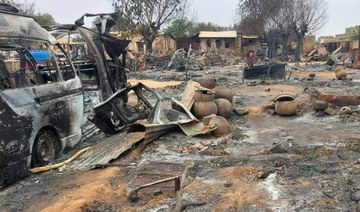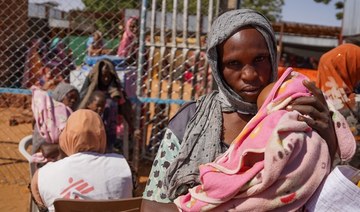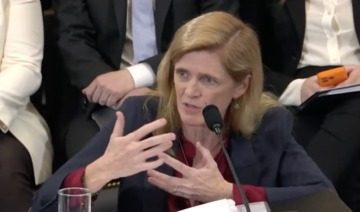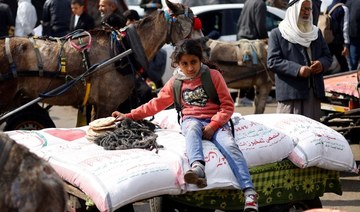BEIRUT: Two months of intensive airstrikes by Syrian government forces and their Russian allies, coupled with a fierce ground assault on rebel-controlled Idlib province, have killed hundreds of people and caused massive displacement while achieving little to no gain for President Bashar Assad.
Despite the heavy bombardment, Assad’s troops have been unable to make any significant advances against Al-Qaeda-linked militants and other extremist groups who dominate Idlib province, the last significant area held by opposition forces. Militant attacks have killed an average of more than a dozen soldiers and allied militiamen a day in recent weeks.
The struggling campaign underscores the limits of Syria’s and Russia’s airpower and inability to achieve a definitive victory in the country’s long-running civil war, now in its eighth year.
With crucial military assistance from Russia and Iran, Syrian troops have in the past few years recovered most other opposition-held parts of the country with crushing offensives and long-running sieges. In each of those places, rebels either surrendered or were forcibly exiled to Idlib, where they are now cornered with nowhere left to go. Bitter and desperate, they can only fight to the end. Abu Mohammed Al-Golani, the leader of the main Al-Qaeda-linked group in the region, has called on every able person to “perform his religious duty” and join the fight.
Sam Heller, a Syria expert with the International Crisis Group who closely follows the situation in the rebel-controlled area, said, “Idlib’s armed opposition may not be able to win an open battle for the northwest, but they can make a Syrian military victory terribly costly, maybe intolerably so.”
Politically, Idlib reflects the tug of war among international players supporting opposing sides of Syria’s conflict. A cease-fire brokered last September by Russia, a key ally of Assad, and Turkey, which supports the rebels, collapsed on April 30 when the government began its offensive following months of violations by both sides. Turkey, which hosts 3 million Syrian refugees, fears a full-blown government offensive would cause a new wave of displaced people heading toward its border, but it has been unable — or some say, unwilling — to control the rebels in Idlib that it supports.
Crucially, Iran-backed fighters, including members of Lebanon’s Hezbollah group whose participation has been key in previous battles, have not joined fight for Idlib, deeming the region a low priority, unlike more strategic areas bordering Iraq and Lebanon. Even Russia hasn’t thrown all its weight into the fray and has continued to talk to Turkey about ways to reinstate the cease-fire.
Rather than a full-blown offensive to recover the province, which is packed with 3 million people, Assad’s government has for now restricted its assault to the edges of the province with the aim of reopening key highways crossing through rebel-held areas. But even that has proved futile as the rebels fight back aggressively.
According to the Syrian Observatory for Human Rights, an opposition war monitor, 2,443 people have been killed since April 30. They include 629 civilians, among them 159 children. The dead also include 869 pro-government fighters and troops as well as 945 insurgents, according to the Observatory. Many more have been wounded and many villages destroyed, with the United Nations saying the fighting has displaced more than 330,000 from their homes. Many of them now live in overcrowded tents near the border with Turkey.
Spearheading the offensive on Idlib and northern parts of the central province of Hama is the government’s elite Tiger Force led by Brig. Gen. Suheil Al-Hassan, a Russian-backed Syrian officer who took credit for some of the biggest government victories in the eight-year conflict.
But he has not succeeded in breaking Idlib’s defenses and remains deadlocked. According to opposition activists, elite forces from the Republican Guards and the Fourth Division led by Assad’s younger brother, Maher, have recently started taking part in the offensive.
Opposition activists say government forces and their Russian allies have been targeting schools and medical centers, reportedly killing 10 medical staff since the offensive began, to make it difficult for the local population to stay. The tactic has been used by government troops elsewhere in Syria. Airstrikes have also targeted paramedics, killing four ambulance workers in recent weeks, activists say.
The Idlib offensive began with government forces capturing more than a dozen villages, including Qalaat Al-Madiq and Kfar Nabudah, which are considered the militants’ first line of defense of Idlib. Since then, Kfar Nabudah has changed hands several times. Insurgents later took government forces by surprise by launching an offensive and opening another front, in which they succeeded in capturing the villages of Madraset Al-Dahra, Tel Milh and Jubain. Repeated government attacks to retake the area were unsuccessful.
Mohammed Al-Ali, a journalist based in Idlib province, said that two months into the offensive the government now only controls the village of Qassabiyeh in Idlib as well as some dozen villages in northern Hama province and the town of Qalaat Al-Madiq.
Al-Ali said one of the insurgents’ biggest successes was opening the new front, in which they cut a main road linking the central city of Hama with government-held villages on the edge of Idlib.
“The rebels’ steadfastness and regime’s heavy losses made them fail to achieve advances similar to those they did at the start,” he said of the government offensive. He said anti-tank missiles were key in slowing the regime’s offensive.
The battle could last for months and claim more lives unless Turkey, Iran and Russia reach a new deal for the region similar to last year’s cease-fire. The faltering offensive could encourage Russia to reach such a deal with Turkey.
Turkey’s presidential spokesman, Ibrahim Kalin, said Ankara is planning to host a summit between the leaders of the three nations in August to discuss Syria, mainly Idlib.
“The Syrian military’s inability so far to make more headway in Idlib does not mean it cannot ultimately achieve victory nationwide,” Heller, of Crisis Group, said. “It does show, however, that its military victory is contingent on politics that -are bigger than just Syria.”
Two-month Idlib campaign nets little for Syria’s Assad
Two-month Idlib campaign nets little for Syria’s Assad
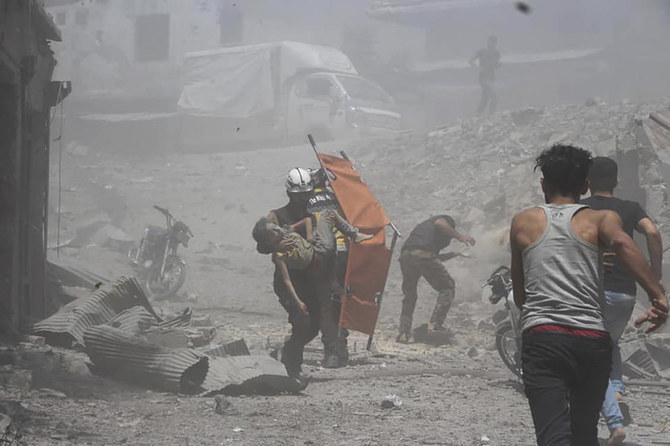
- Despite the heavy bombardment, Assad’s troops have been unable to make any significant advances against Al-Qaeda-linked militants and other extremist groups who dominate Idlib province
- Rather than a full-blown offensive to recover the province, which is packed with 3 million people, Assad’s government has for now restricted its assault to the edges of the province with the aim of reopening key highways crossing through rebel-held areas
UN official warns famine in northern Gaza is already ‘full-blown’
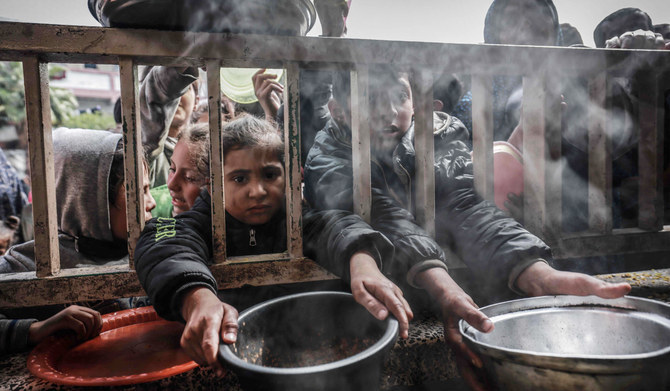
- Israel has killed more than 34,000 Palestinians since Oct. 7 attacks by Hamas
- There was no immediate comment from Israel, which controls entrance into Gaza
WASHINGTON: A top UN official said Friday that hard-hit northern Gaza was now in “full-blown famine” after more than six months of war between Israel and Hamas and severe Israeli restrictions on food deliveries to the Palestinian territory.
Cindy McCain, the American director of the UN World Food Program, became the most prominent international official so far to declare that trapped civilians in the most cut-off part of Gaza had gone over the brink into famine.
“It’s horror,” McCain told NBC’s “Meet the Press” in an interview to air Sunday. “There is famine — full-blown famine — in the north, and it’s moving its way south.”
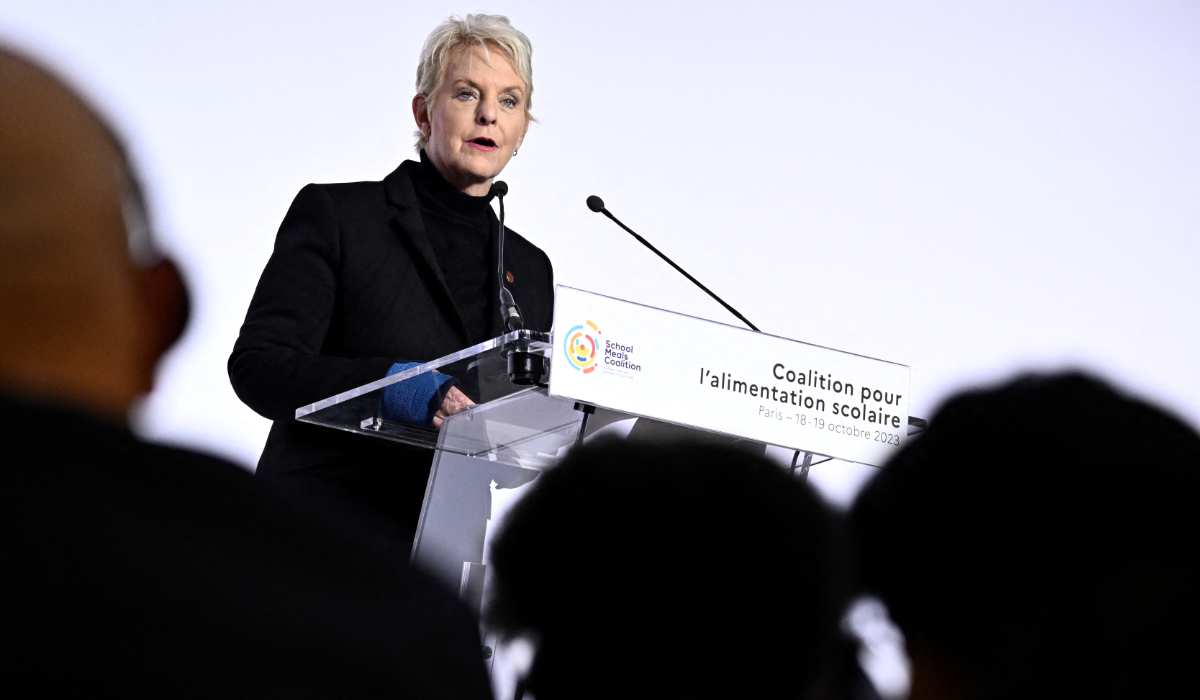
She said a ceasefire and a greatly increased flow of aid through land and sea routes was essential to confronting the growing humanitarian catastrophe in Gaza, home to 2.3 million people.
There was no immediate comment from Israel, which controls entrance into Gaza and says it is beginning to allow in more food and other humanitarian aid through land crossings.
The panel that serves as the internationally recognized monitor for food crises said earlier this year that northern Gaza was on the brink of famine and likely to experience it this month. The next update will not come before this summer.
One of the US Agency for International Development’s humanitarian officials in Gaza told The Associated Press that on-the-ground preparations for a new US-led sea route were on track to bring in more food — including treatment for hundreds of thousands of starving children — by early or mid-May. That’s when the American military expects to finish building a floating pier to receive the shipments.
Ramping up the delivery of aid on the planned US-backed sea route will be gradual as aid groups test the distribution and security arrangements for relief workers, the USAID official said.
The official spoke on condition of anonymity over security concerns for work done in a conflict zone. They were some of the agency’s first comments on the status of preparations for the Biden administration’s $320 million Gaza pier project, for which USAID is helping coordinate on-the-ground security and distribution.
At a factory in rural Georgia on Friday, USAID Administrator Samantha Power pointed to the food crises in Gaza and other parts of the world as she announced a $200 million investment aimed at increasing production of emergency nutritional paste for starving children under 5.
Power spoke to factory workers, peanut farmers and local dignitaries sitting among pallets of the paste at the Mana nonprofit in Fitzgerald. It is one of two factories in the US that produces the nutritional food, which is used in clinical settings and made from ground peanuts, powdered milk, sugar and oil, ready to eat in plastic pouches resembling large ketchup packets.
“This effort, this vision meets the moment,” Power said. “And it could not be more timely, more necessary or more important.”
Under pressure from the US and others, Israeli officials in recent weeks have begun slowly reopening some border crossings for relief shipments.
But aid coming through the sea route, once it’s operational, still will serve only a fraction — half a million people — of those who need help in Gaza. Aid organizations including USAID stress that getting more aid through border crossings is essential to staving off famine.
Children under 5 are among the first to die when wars, droughts or other disasters curtail food. Hospital officials in northern Gaza reported the first deaths from hunger in early March and said most of the dead were children.
Power said the UN has called for 400 metric tons of the nutritional paste “in light of the severe hunger that is pervading across Gaza right now, and the severe, acute humanitarian crisis.” USAID expects to provide a quarter of that, she said.
Globally, she said at the Georgia factory, the treatment made there “will save untold lives, millions of lives.”
USAID is coordinating with the World Food Program and other humanitarian partners and governments on security and distribution for the pier project, while US military forces finish building it. President Joe Biden, under pressure to do more to ease the humanitarian catastrophe in Gaza as the US provides military support for Israel, announced the project in early March.
US Central Command said in a statement Friday that offshore assembly of the floating pier has been temporarily paused due to high winds and sea swells, which caused unsafe conditions for soldiers. The partially built pier and the military vessels involved have gone to Israel’s Port of Ashdod, where the work will continue.
A US official said the high seas will delay the installation for several days, possibly until later next week. The official, who spoke on condition of anonymity to discuss operation details, said the pause could last longer if the bad weather continues because military personnel and divers have to get into the water for the final installation.
The struggles this week with the first aid delivery through a newly reopened land corridor into north Gaza underscored the uncertainty about security and the danger still facing relief workers. Israeli settlers blocked the convoy before it crossed Wednesday. Once inside Gaza, the convoy was commandeered by Hamas militants, before UN officials reclaimed it.
In Gaza, the nutritional treatment for starving children is most urgently needed in the northern part of the Palestinian territory. Civilians have been cut off from most aid supplies, bombarded by Israeli airstrikes and driven into hiding by fighting.
Acute malnutrition rates there among children under 5 have surged from 1 percent before the war to 30 percent five months later, the USAID official said. The official called it the fastest such climb in hunger in recent history, more than in grave conflicts and food shortages in Somalia or South Sudan.
One of the few medical facilities still operating in northern Gaza, Kamal Adwan hospital, is besieged by parents bringing in thousands of children with malnutrition for treatment, the official said. Aid officials believe many more starving children remain unseen and in need, with families unable to bring them through fighting and checkpoints for care.
Saving the gravely malnourished children in particular requires both greatly increased deliveries of aid and sustained calm in fighting, the official said, so that aid workers can set up treatment facilities around the territory and families can safely bring children in for the sustained treatment needed.
The UN warns Sudan’s warring parties that Darfur risks starvation and death if aid is not allowed in
The UN warns Sudan’s warring parties that Darfur risks starvation and death if aid is not allowed in
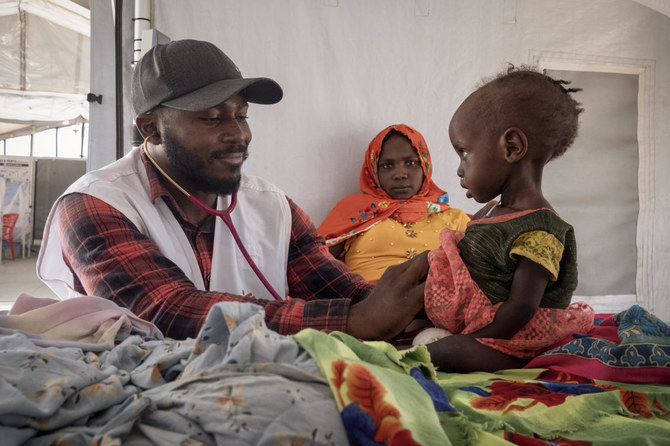
- At least 1.7 million people in Darfur were experiencing emergency levels of hunger in December
- Sudan plunged into chaos in mid-April 2023, when long-simmering tensions between the military and the paramilitary forces broke out into street battles
UNITED NATIONS: The United Nations food agency warned Sudan’s warring parties Friday that there is a serious risk of widespread starvation and death in Darfur and elsewhere in Sudan if they don’t allow humanitarian aid into the vast western region.
Leni Kinzli, the World Food Programme’s regional spokesperson, said at least 1.7 million people in Darfur were experiencing emergency levels of hunger in December, and the number “is expected to be much higher today.”
“Our calls for humanitarian access to conflict hotspots in Sudan have never been more critical,” she told a virtual UN press conference from Nairobi.
Sudan plunged into chaos in mid-April 2023, when long-simmering tensions between its military led by Gen. Abdel Fattah Burhan, and the paramilitary Rapid Support Forces commanded by Mohammed Hamdan Dagalo, broke out into street battles in the capital, Khartoum. Fighting has spread to other parts of the country, especially urban areas and the Darfur region.
The paramilitary forces, known as the RSF, have gained control of most of Darfur and are besieging El Fasher, the only capital in Darfur they don’t hold, where some 500,000 civilians had taken refuge.
Kinzli said WFP’s partners on the ground report that the situation in El Fasher is “extremely dire” and it’s difficult for civilians wanting to flee the reported RSF bombings and shelling to leave.
She said the violence in El Fasher and surrounding North Darfur is exacerbating the critical humanitarian needs in the entire Darfur region, where crop production for staple cereals like wheat, sorghum and millet is 78 percent less than the five-year average.
On top of the impact of escalating violence, Kinzli said, “WFP is concerned that hunger will increase dramatically as the lean season between harvests sets in and people run out of food.” She said a farmer in El Fasher recently told her that her family had already run out of food stocks and is living day-to-day, an indication that the “lean season,” which usually starts in May, started earlier.
Kinzli said she received photos earlier Friday from colleagues on the ground of severely malnourished children in a camp for displaced people in Central Darfur, as well as older people “who have nothing left but skin and bones.”
“Recent reports from our partners indicate that 20 children have died in recent weeks of malnutrition in that IDP camp,” she said.
“People are resorting to consuming grass and peanut shells,” Kinzli said. “And if assistance doesn’t reach them soon, we risk witnessing widespread starvation and death in Darfur and across other conflict-affected areas in Sudan.”
Kinzli called for “a concerted diplomatic effort by the international community to push the warring parties to provide access and safety guarantees” for humanitarian staff and convoys.
“One year of this devastating conflict in Sudan has created an unprecedented hunger catastrophe and threatens to ignite the world’s largest hunger crisis,” she warned. “With almost 28 million people facing food insecurity across Sudan, South Sudan and Chad, the conflict is spilling over and exacerbating the challenges that we’ve already been facing over the last year.”
In March, Sudanese authorities revoked WFP’s permission to deliver aid from neighboring Chad to West Darfur and Central Darfur from the town of Adre, saying that crossing had been used to transfer weapons to the RSF. Kinzli said restrictions from Sudanese authorities in Port Sudan are also preventing WFP from transporting aid via Adre.
Sudanese authorities approved the delivery of aid from the Chadian town of Tina to North Darfur, but Kinzli said WFP can no longer use that route for security reasons because it goes directly into besieged El Fasher.
On Thursday, gunmen in South Darfur killed two drivers for the International Committee of the Red Cross and injured three ICRC staff members. On Friday, UN humanitarian chief Martin Griffith called the killing of aid works “unconscionable.”
Kinzli said the fighting “and endless bureaucratic hurdles” have prevented WFP from delivering aid to over 700,000 people in Darfur ahead of the rainy season when many roads become impassable.
“WFP currently has 8,000 tons of food supplies ready to move in Chad, ready to transport, but is unable to do so because of these constraints,” she said.
“WFP urgently requires unrestricted access and security guarantees to deliver assistance,” she said. “And we must be able to use the Adre border crossing, and move assistance across front lines from Port Sudan in the east to Darfur so we can reach people in this desperate region.”
Hamas ‘only thing standing between the people of Gaza and a ceasefire’: Blinken

- ‘We wait to see whether, in effect, they can take yes for an answer on the ceasefire and release of hostages’
- But official says US cannot support a major military operation going into Rafah
“We wait to see whether, in effect, they can take yes for an answer on the ceasefire and release of hostages,” Blinken said late Friday.
“The reality in this moment is the only thing standing between the people of Gaza and a ceasefire is Hamas.”
Blinken pointed to difficulties in negotiating with Hamas, which the United States considers a terrorist group and does not engage with directly and which Israel has vowed to eliminate.
“The leaders of Hamas that we’re indirectly engaged with — through the Qataris, through the Egyptians — are, of course, living outside of Gaza,” Blinken said.
“The ultimate decision-makers are the folks who are actually in Gaza itself with whom none of us have direct contact.”
Blinken was addressing a dinner at the McCain Institute’s Sedona Forum in Arizona two days after meeting Israeli Prime Minister Benjamin Netanyahu and other top leaders on his latest visit to the Middle East.
Ahead of his talks with Blinken, Netanyahu vowed to push ahead with an assault on the southern Gaza city of Rafah to root out Hamas regardless of the outcome of negotiations for a temporary ceasefire that would involve the release of hostages.
President Joe Biden’s administration has repeatedly warned Netanyahu’s government against moving on Rafah, where some 1.4 million Palestinians have taken shelter after fleeing the Israeli assault in response to the October 7 attack by Hamas.
Blinken said that Israel, which counts on the United States for military and diplomatic support, has yet to present “a credible plan to genuinely protect the civilians who are in harm’s way” in Rafah.
“Absent such a plan, we can’t support a major military operation going into Rafah because the damage it would do is beyond what’s acceptable,” Blinken said.
France condemns attack on Red Cross in Sudan
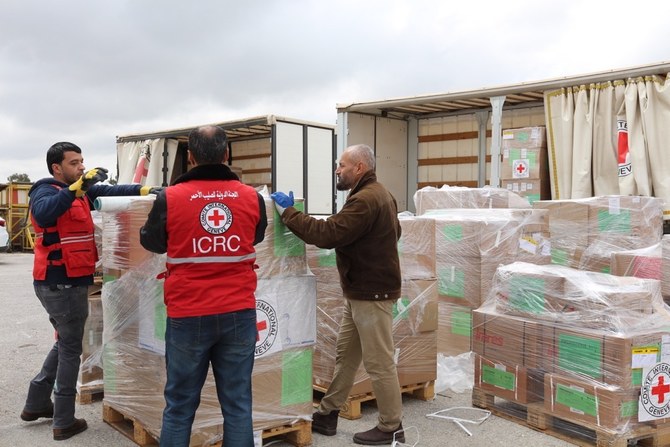
PARIS: France on Friday condemned “in the strongest terms” an attack on an International Committee of the Red Cross convoy in war-torn Sudan that killed two staff and injured three others.
“France calls on all parties to the conflict to respect their obligations under international humanitarian law, which obliges them to protect humanitarian and health staff and guarantee complete, safe and unhindered humanitarian access,” said French foreign ministry spokesman Christophe Lemoine.
The ICRC said gunmen killed two drivers and injured three staff in South Darfur on Thursday as they returned from a humanitarian mission.
A brutal conflict between the Sudanese army led by General Abdel Fattah Al-Burhan and the paramilitary Rapid Support Forces of his ex-deputy Mohamed Hamdan Dagalo has torn the country apart for more than a year.
The war has killed tens of thousands of people and forced millions more to flee their homes in what the United Nations has called the “largest displacement crisis in the world.”
It has also triggered acute food shortages and a humanitarian crisis that has left the northeast African country’s people at risk of starvation.
UN official warns that famine in northern Gaza is already ‘full-blown’

- Israel has killed more than 34,000 Palestinians, according to Gaza’s Health Ministry
- The panel that serves as the internationally recognized monitor for food crises said earlier this year that northern Gaza was on the brink of famine and likely to experience it this month
WASHINGTON: A top UN official said Friday that hard-hit northern Gaza was now in “full-blown famine” after more than six months of war between Israel and Hamas and severe Israeli restrictions on food deliveries to the Palestinian territory.
Cindy McCain, the American director of the UN World Food Program, became the most prominent international official so far to declare that trapped civilians in the most cut-off part of Gaza had gone over the brink into famine.
“It’s horror,” McCain told NBC’s “Meet the Press” in an interview to air Sunday. “There is famine — full-blown famine — in the north, and it’s moving its way south.”

She said a ceasefire and a greatly increased flow of aid through land and sea routes was essential to confronting the growing humanitarian catastrophe in Gaza, home to 2.3 million people.
There was no immediate comment from Israel, which controls entrance into Gaza and says it is beginning to allow in more food and other humanitarian aid through land crossings.
The panel that serves as the internationally recognized monitor for food crises said earlier this year that northern Gaza was on the brink of famine and likely to experience it this month. The next update will not come before this summer.
One of the US Agency for International Development’s humanitarian officials in Gaza told The Associated Press that on-the-ground preparations for a new US-led sea route were on track to bring in more food — including treatment for hundreds of thousands of starving children — by early or mid-May. That’s when the American military expects to finish building a floating pier to receive the shipments.
Ramping up the delivery of aid on the planned US-backed sea route will be gradual as aid groups test the distribution and security arrangements for relief workers, the USAID official said.
The official spoke on condition of anonymity over security concerns for work done in a conflict zone. They were some of the agency’s first comments on the status of preparations for the Biden administration’s $320 million Gaza pier project, for which USAID is helping coordinate on-the-ground security and distribution.
At a factory in rural Georgia on Friday, USAID Administrator Samantha Power pointed to the food crises in Gaza and other parts of the world as she announced a $200 million investment aimed at increasing production of emergency nutritional paste for starving children under 5.
Power spoke to factory workers, peanut farmers and local dignitaries sitting among pallets of the paste at the Mana nonprofit in Fitzgerald. It is one of two factories in the US that produces the nutritional food, which is used in clinical settings and made from ground peanuts, powdered milk, sugar and oil, ready to eat in plastic pouches resembling large ketchup packets.
“This effort, this vision meets the moment,” Power said. “And it could not be more timely, more necessary or more important.”
Under pressure from the US and others, Israeli officials in recent weeks have begun slowly reopening some border crossings for relief shipments.
But aid coming through the sea route, once it’s operational, still will serve only a fraction — half a million people — of those who need help in Gaza. Aid organizations including USAID stress that getting more aid through border crossings is essential to staving off famine.
Children under 5 are among the first to die when wars, droughts or other disasters curtail food. Hospital officials in northern Gaza reported the first deaths from hunger in early March and said most of the dead were children.
Power said the UN has called for 400 metric tons of the nutritional paste “in light of the severe hunger that is pervading across Gaza right now, and the severe, acute humanitarian crisis.” USAID expects to provide a quarter of that, she said.
Globally, she said at the Georgia factory, the treatment made there “will save untold lives, millions of lives.”
USAID is coordinating with the World Food Program and other humanitarian partners and governments on security and distribution for the pier project, while US military forces finish building it. President Joe Biden, under pressure to do more to ease the humanitarian catastrophe in Gaza as the US provides military support for Israel, announced the project in early March.
US Central Command said in a statement Friday that offshore assembly of the floating pier has been temporarily paused due to high winds and sea swells, which caused unsafe conditions for soldiers. The partially built pier and the military vessels involved have gone to Israel’s Port of Ashdod, where the work will continue.
A US official said the high seas will delay the installation for several days, possibly until later next week. The official, who spoke on condition of anonymity to discuss operation details, said the pause could last longer if the bad weather continues because military personnel and divers have to get into the water for the final installation.
The struggles this week with the first aid delivery through a newly reopened land corridor into north Gaza underscored the uncertainty about security and the danger still facing relief workers. Israeli settlers blocked the convoy before it crossed Wednesday. Once inside Gaza, the convoy was commandeered by Hamas militants, before UN officials reclaimed it.
In Gaza, the nutritional treatment for starving children is most urgently needed in the northern part of the Palestinian territory. Civilians have been cut off from most aid supplies, bombarded by Israeli airstrikes and driven into hiding by fighting.
Acute malnutrition rates there among children under 5 have surged from 1 percent before the war to 30 percent five months later, the USAID official said. The official called it the fastest such climb in hunger in recent history, more than in grave conflicts and food shortages in Somalia or South Sudan.
One of the few medical facilities still operating in northern Gaza, Kamal Adwan hospital, is besieged by parents bringing in thousands of children with malnutrition for treatment, the official said. Aid officials believe many more starving children remain unseen and in need, with families unable to bring them through fighting and checkpoints for care.
Saving the gravely malnourished children in particular requires both greatly increased deliveries of aid and sustained calm in fighting, the official said, so that aid workers can set up treatment facilities around the territory and families can safely bring children in for the sustained treatment needed.



